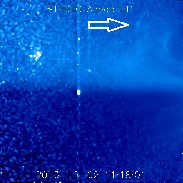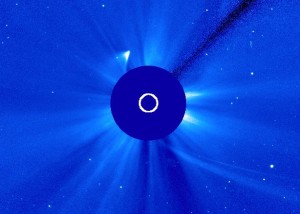COMET ISON, R.I.P
- December 2, 2013
Following its Thanksgiving Day brush with solar fire, sundiving Comet ISON is now just a cloud of dust. Among experts, a consensus is building that the comet broke apart shortly before perihelion (closest approach to the sun).
After perihelion, the comet emerges as a diffuse remnant of its former self. No one knows for sure what is inside that fan-shaped cloud. Possibilities include a small remnant nucleus or a “rubble pile” of furiously vaporizing fragments. By the end of the day on Nov. 28th, Comet ISON was spent.
As of Dec. 2nd, the cloud of debris is no brighter than a star of approximately 8th magnitude. Experienced astrophotographers might be able to capture the comet’s fading “ghost” in the pre-dawn sky of early December, but a naked-eye spectacle is out of the question.
Spaceweather.com, December 2, 2013
Comet C/2012 S1 (ISON) ON STEREO HI1-A
Taken by Nunzio M. on December 3, 2013 @ Vieste(FG), Italy



